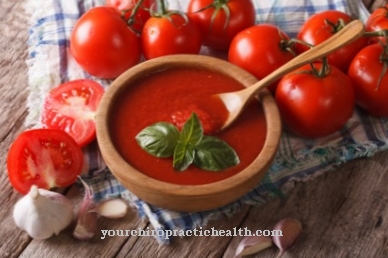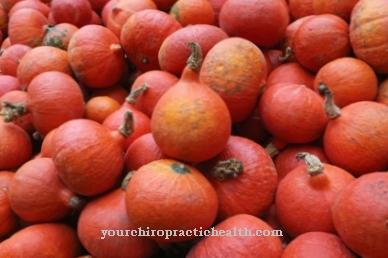As Hazelnuts the fruits of the hazel bush are called. Most of the hazelnuts come from Asia Minor and Europe. They contain many important nutrients and are commonly known as nerve food. Although hazelnuts are generally beneficial to health, they can cause allergies or intolerance.
What you should know about the hazelnut

The hazelnut bush, also called common hazel, belongs to the birch family. The hazelnuts grow as fruits on the hazel bush and, in contrast to walnuts or almonds, are among the "real nuts".
They are mainly imported from Turkey. However, the shrubs are also grown in other European countries as well as in Asia or the USA. In Germany, many hazelnut bushes can also be found in domestic gardens. However, since the hazel does not bear enough fruit in this country, it is not used for trade.
There are two different types of hazelnuts: the cell nuts and the filbert nuts. While cell nuts often grow in Germany, Lambert nuts mostly come from the more southern countries. Due to the optimal climatic conditions, this variety is sweeter and tastier. Overall, the taste of the hazelnut can be described as hearty and spicy. The hazelnut bush is reminiscent of the shape of a tree. It has one trunk and can grow up to six meters high.
The hazel already blooms in February to March, mostly on the edge of dense forests or in clearings. Although the harvest time is only in September and October, the nuts are available in stores all year round thanks to the optimized production and storage conditions. But especially in autumn and winter, hazelnuts are in season in this country and can be found in almost every supermarket.
Importance to health
Some time ago, hazelnuts were considered hazardous to health due to their fats and the resulting calories. But although they contain a lot of fats and oils, scientists have now found that they are extremely healthy and important for general nutrition.
The fats that the hazelnut contains consist mainly of unsaturated fatty acids. They represent the good fats that have a positive effect on cholesterol levels and can strengthen the heart. However, it is important that you eat nuts in moderation. Up to 25 g can be consumed per day. The magnesium contained in hazelnuts can relax the nervous system and regulate blood pressure. Inflammation can also be prevented with magnesium.
The folic acid it contains helps to reduce the build-up of deposits in the arteries, so that the heart and blood vessels are protected. In conjunction with carbohydrates, nuts can reduce the usual rise in blood sugar and the associated risk of diabetes. Nuts are also known as nerve foods and trail mixes. Chewing the nuts stimulates brain activity. The high content of lecithins and choline strengthens memory and regulates nerve function.
The human body converts certain amino acids contained in hazelnuts into the messenger substance serotonin, which brightens the mood and helps against depression.
Ingredients & nutritional values
100 grams of hazelnuts contain around 650 kcal. In addition to the relatively high fat content of around 62 g per 100 g, hazelnuts also consist of around 12% protein. This makes them an important and indispensable source of protein, especially for vegetarians and vegans.
The nut also contains many important minerals such as calcium, magnesium, potassium, phosphorus, zinc and iron. B group vitamins, vitamin C, folic acid, and beta-carotene are also found in substantial amounts. Hazelnuts also contain a lot of fiber, which is of great importance for proper digestion. The vitamin E contained in hazelnuts also defends the cells against free radicals.
Intolerances & allergies
However, like other nuts, hazelnuts can be very dangerous for allergy sufferers. In many cases, people who react positively to birch pollen also cannot tolerate hazelnuts. This is because the hazel bush is a birch plant and contains the same allergenic substances as the birch. This close relationship is also known as a cross allergy and is very common.
An intolerance often manifests itself in the form of stomach problems, diarrhea or nausea. But swelling in the mouth or eyes, an itchy throat or mouth can also occur after consuming hazelnuts. In the worst case, anaphylaxis can occur, which in certain circumstances can be life-threatening.
Shopping & kitchen tips
In the supermarket, hazelnuts are mostly offered peeled and unpeeled. They are also available ground or chopped as a baking ingredient. In any case, the nuts should be undamaged and should not contain any evidence of mold.
Because when the hazelnuts are infected with mold, harmful toxins form, so that they must not be consumed under any circumstances. Nuts packed in a net or loose nuts are less prone to mold growth. Hazelnuts, on the other hand, which are offered in plastic sheeting, should be avoided as more liquid forms there, which leads to mold growth.
Shelled hazelnuts can be subjected to a simple test to see if the nut is still fresh. If it rattles in the shell when you shake it, the nuts are often already dried out. In addition, the larger it is, the more aromatic the nut is. When the nuts are shelled, they have a white skin. Slightly yellowish discolored specimens indicate that it is already a somewhat older nut. These mostly taste rancid or hardly have any taste.
This food generally lasts for a few months. However, both peeled and unpeeled hazelnuts should be kept cool and airtight. The refrigerator, the cellar or less heated rooms are best suited for this. If the nuts are under a plastic sheet, this should be removed in any case.
Whole nuts should be chopped or crushed beforehand as an ingredient in a cake or other pastry. Whole nuts are very good as a snack between meals.
Preparation tips
Hazelnuts can refine both sweet dishes and savory dishes. Chopped or ground nuts are mostly used as a baking ingredient. Whole hazelnuts can be eaten raw or roasted or candied. If the hazelnuts are roasted in the oven for about 10 minutes, they are tastier, have a stronger aroma and the skin is easier to loosen. To do this, the nuts are rubbed together in a cloth after roasting until the skin loosens.
Schnapps or liqueurs can also be made from this superfood. In order to avoid a bitter taste, the peel and skin must be completely removed. In order not to lose the intense aroma, the nuts should be processed further immediately after processing.



























